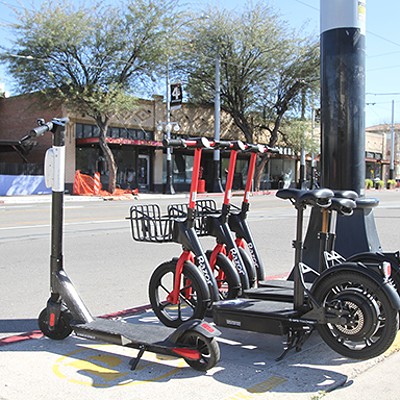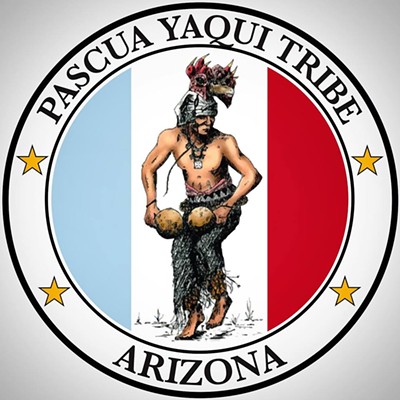Some of those who will be impacted by the proposal, however, are not buying the idea.
Vicki Mills, a resident near the intersection of Grant Road and Campbell Avenue who had just learned about the "Michigan left," comments: "It's hard to imagine it working. It may prove to be a brilliant idea, but it doesn't seem to make logical sense."
Here's how the Michigan left--utilized in the state since the 1960s--works: Left turns aren't allowed at major intersections. Instead, turning traffic is funneled into a turn bay beyond the intersection, where vehicles make a signal-controlled U-turn and then head in the opposite direction to make a right turn.
Tucson's Department of Transportation wants to incorporate this idea at seven intersections along Grant Road when the street is eventually widened, and lists benefits including greater traffic efficiency, reduced fuel consumption, increased safety for both vehicles and pedestrians, and a smaller roadway footprint that may mean lower construction costs.
"The benefits mostly accrue to the through traffic," acknowledges Jim Glock, the city's director of transportation. He cites projections that show the amount of time that traffic is stopped at the intersections is reduced by 42 percent.
Glock adds that because of the smaller size of the intersections used under the Michigan model, pedestrians will also be better off. "We hope to provide more pedestrian-friendly intersections," he says.
While safety is not emphasized by either Glock or project consultant Dave Perkins, that is the primary reason the state of Michigan uses the unorthodox left turn. According to the Federal Highway Administration, this type of intersection "offers the potential for a major decrease in left-turn collisions."
One potential drawback to the "Michigan left" is that too many vehicles could line up to turn left, thus backing into a through lane. But Perkins doesn't think that will happen on Grant Road.
"According to our analysis," he says, "there should be sufficient capacity (in the U-turn bay)." As a backup, Perkins points out that the U-turn signal can be independently changed to clear the congestion.
Another possible problem with this type of left turn: confusion. But Barbara Hicks of the Michigan Department of Transportation says that isn't an issue with proper signage. At the same time, Hicks does admit: "Some in Michigan like the turns; some don't."
Among those who might not like the idea are truck drivers. To accommodate the wide turns made by these vehicles, there will be "bulb-outs" along Grant Road. Glock says that at these "bulb-out" points, access to surrounding neighborhoods will be altered.
"Our recommendation is there will be no access out of the neighborhoods (at these points)," Glock states. Whether the residents want access in, he adds, will be determined later this year through a series of meetings.
The proposed change in Grant Road access will have a substantial impact on the residents of the El Cortez Heights Neighborhood. Nestled into the southwest corner of Grant and First Avenue, the area would see northward access completely eliminated, according to neighborhood association president Tori Stypula.
"I'm disappointed (the city) didn't take a look at the needs of our neighborhood," Stypula says. "They've effectively cut us off."
Because of the irregular pattern of streets in the area, combined with the proposed changes to Grant Road, Stypula believes that drivers would have to take residential streets more than a half-mile west to Stone Avenue before they could go north. In addition, she says, getting to the Fry's grocery store directly across Grant Road from her neighborhood would involve a major driving excursion.
"I'm not a fan of the Michigan left," Stypula comments. Despite that, she says she probably won't be attending the City Council public hearing when the proposed Grant Road alignment is discussed.
"They say we have a say," Stypula says about the project's planning process, "but we don't have a say. ... They're going to do what they want to do."
A random survey of a half-dozen shopkeepers near Grant and Campbell revealed generally lukewarm responses to the Michigan left concept. Opinions ranged from "it's stupid" and "bizarre" to "mixed feelings," "I trust they know what they're doing," and finally, "It's a great idea."
Beverly Rutter, who lives near the Grant/Campbell intersection, thinks the Michigan left could be a positive. She's a member of the Grant Road Improvement Plan Task Force, a group which helped develop the proposed alignment for the widened roadway, including the Michigan left.
"It's an experimental thing." Rutter says.
"Experimental" was also the term used in 1967 regarding the proposal to introduce a reversible rush-hour lane of traffic to Broadway Boulevard, and later Grant Road. Implemented to facilitate a greater flow of vehicles, the controversial idea hung around for decades until changing traffic patterns nullified its effectiveness.
Whether the same ignoble fate awaits the Michigan left in Tucson remains to be seen.












